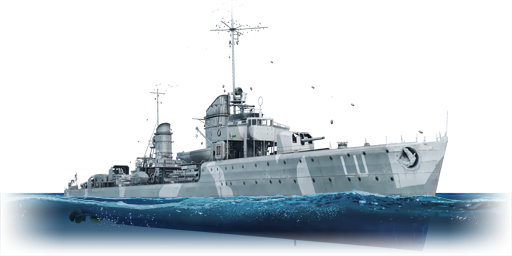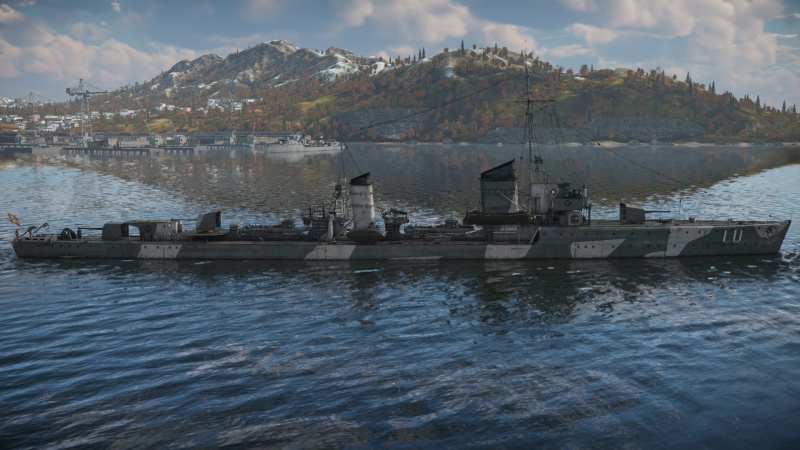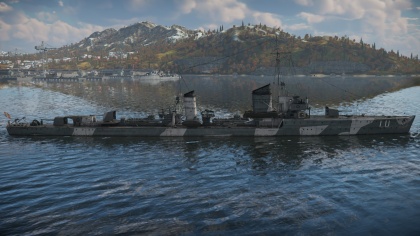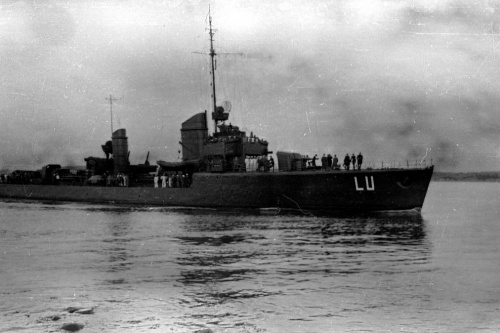Luchs
Contents
Description
The Raubtier-class, Luchs, 1932 is a premium rank I German destroyer
with a battle rating of 3.7 (AB/RB/SB). It was introduced in Update "New Power".
General info
Survivability and armour
Talk about the vehicle's armour. Note the most well-defended and most vulnerable zones, e.g. the ammo magazine. Evaluate the composition of components and assemblies responsible for movement and manoeuvrability. Evaluate the survivability of the primary and secondary armaments separately. Don't forget to mention the size of the crew, which plays an important role in fleet mechanics. Save tips on preserving survivability for the "Usage in battles" section. If necessary, use a graphical template to show the most well-protected or most vulnerable points in the armour.
Mobility
Write about the ship's mobility. Evaluate its power and manoeuvrability, rudder rerouting speed, stopping speed at full tilt, with its maximum forward and reverse speed.
| Mobility Characteristics | |||
|---|---|---|---|
| Game Mode | Upgrade Status | Maximum Speed (km/h) | |
| Forward | Reverse | ||
| AB | |||
| Upgraded | 77 | 31 | |
| RB/SB | |||
| Upgraded | 63 | 26 | |
Modifications and economy
Armament
Primary armament
Provide information about the characteristics of the primary armament. Evaluate their efficacy in battle based on their reload speed, ballistics and the capacity of their shells. Add a link to the main article about the weapon: {{main|Weapon name (calibre)}}. Broadly describe the ammunition available for the primary armament, and provide recommendations on how to use it and which ammunition to choose.
Secondary armament
Some ships are fitted with weapons of various calibres. Secondary armaments are defined as weapons chosen with the control Select secondary weapon. Evaluate the secondary armaments and give advice on how to use them. Describe the ammunition available for the secondary armament. Provide recommendations on how to use them and which ammunition to choose. Remember that any anti-air armament, even heavy calibre weapons, belong in the next section. If there is no secondary armament, remove this section.
Torpedo armament
Torpedo launchers are standard equipment on many ships and boats. Torpedoes are a significant means of defeating an opponent. Evaluate the position of the torpedo launchers, discuss the ammunition available, firing specifics such as dead zones, features of the torpedoes themselves, etc. If there is no torpedo armament, remove this section.
Additional armament
Describe the available additional armaments of the ship: depth charges, mines, torpedoes. Talk about their positions, available ammunition and launch features such as dead zones of torpedoes.
If there is no additional armament, remove this section.
Usage in battles
Describe the technique of using this ship, the characteristics of her use in a team and tips on strategy. Abstain from writing an entire guide – don't try to provide a single point of view, but give the reader food for thought. Talk about the most dangerous opponents for this vehicle and provide recommendations on fighting them. If necessary, note the specifics of playing with this vehicle in various modes (AB, RB, SB).
Description
The Raubtier-class, Luchs, 1932 is a premium rank I German destroyer
with a battle rating of 3.7 (AB/RB/SB). It was introduced in Update "New Power".
General info
Survivability and armour
Talk about the vehicle's armour. Note the most well-defended and most vulnerable zones, e.g. the ammo magazine. Evaluate the composition of components and assemblies responsible for movement and manoeuvrability. Evaluate the survivability of the primary and secondary armaments separately. Don't forget to mention the size of the crew, which plays an important role in fleet mechanics. Save tips on preserving survivability for the "Usage in battles" section. If necessary, use a graphical template to show the most well-protected or most vulnerable points in the armour.
Mobility
Write about the ship's mobility. Evaluate its power and manoeuvrability, rudder rerouting speed, stopping speed at full tilt, with its maximum forward and reverse speed.
| Mobility Characteristics | |||
|---|---|---|---|
| Game Mode | Upgrade Status | Maximum Speed (km/h) | |
| Forward | Reverse | ||
| AB | |||
| Upgraded | 77 | 31 | |
| RB/SB | |||
| Upgraded | 63 | 26 | |
Modifications and economy
Armament
Primary armament
Provide information about the characteristics of the primary armament. Evaluate their efficacy in battle based on their reload speed, ballistics and the capacity of their shells. Add a link to the main article about the weapon: {{main|Weapon name (calibre)}}. Broadly describe the ammunition available for the primary armament, and provide recommendations on how to use it and which ammunition to choose.
Secondary armament
Some ships are fitted with weapons of various calibres. Secondary armaments are defined as weapons chosen with the control Select secondary weapon. Evaluate the secondary armaments and give advice on how to use them. Describe the ammunition available for the secondary armament. Provide recommendations on how to use them and which ammunition to choose. Remember that any anti-air armament, even heavy calibre weapons, belong in the next section. If there is no secondary armament, remove this section.
Torpedo armament
Torpedo launchers are standard equipment on many ships and boats. Torpedoes are a significant means of defeating an opponent. Evaluate the position of the torpedo launchers, discuss the ammunition available, firing specifics such as dead zones, features of the torpedoes themselves, etc. If there is no torpedo armament, remove this section.
Additional armament
Describe the available additional armaments of the ship: depth charges, mines, torpedoes. Talk about their positions, available ammunition and launch features such as dead zones of torpedoes.
If there is no additional armament, remove this section.
Usage in battles
Describe the technique of using this ship, the characteristics of her use in a team and tips on strategy. Abstain from writing an entire guide – don't try to provide a single point of view, but give the reader food for thought. Talk about the most dangerous opponents for this vehicle and provide recommendations on fighting them. If necessary, note the specifics of playing with this vehicle in various modes (AB, RB, SB).
Modules
| Tier | Seakeeping | Unsinkability | Firepower | |||
|---|---|---|---|---|---|---|
| I | Dry-Docking | Tool Set | 12.7 cm Sprgr. L/4.4 Bd.Z | 20 mm HET magazines | ||
| II | Rudder Replacement | Fire Protection System | Smokescreen | 12.7 cm Sprgr. L/4.4 Zt.Z | 20 mm APT magazines | Auxiliary Armament Targeting |
| III | Propeller Replacement | Shrapnel Protection | Ventilation | Improved Rangefinder | Primary Armament Targeting | |
| IV | Engine Maintenance | New Pumps | Ammo Wetting | Torpedo Mode | ||
| This is a premium vehicle: all modifications are unlocked on purchase | ||||||
|
Pros and cons
Summarise and briefly evaluate the vehicle in terms of its characteristics and combat effectiveness. Mark its pros and cons in the bulleted list. Try not to use more than 6 points for each of the characteristics. Avoid using categorical definitions such as "bad", "good" and the like - use substitutions with softer forms such as "inadequate" and "effective".
Pros:
Cons:
History
The Type 1924 Luchs was the fourth of six Type 1924 large torpedo boats built for the Kriegsmarine in the 1920s. With a substantial main and secondary armament, the Type 1924 class ships were among the heaviest armed torpedo boats of their era. Luchs was commissioned in the late 1920s, and sailed on several non-intervention patrols during the Spanish Civil War. She served extensively during the early days of the Second World War and was eventually sunk by a torpedo or mine in July of 1940.
Design and development
The “Type 24” class of 1924 were a class of six heavy torpedo boats built for the German navy. Despite them being extremely heavily armed and close to destroyer-size, they were classified as torpedo boats by the German navy. In War Thunder, these vessels are classified as destroyers. The ships displaced 1300 tons full load and could make a top speed of 34 knots (63 km/h). They had a crew of 129 crew members, which was relatively small for a destroyer but large for a torpedo boat. Luchs carried three 10.5 cm (4 inch) naval guns, as well as six 533 mm torpedo tubes. Later on, she received four 2 cm Flakvierling anti-aircraft guns for air defence. Luchs was the fourth ship of her class to be laid down, in April of 1927 at Wilhelmshaven. Following her completion, she was commissioned in April of 1929.
Operational history
After her commissioning, the Luchs sailed on several non-intervention patrols to the area around Spain during the Spanish Civil War; there is little other information about her pre-war service. Upon the start of the Second World War, Luchs was active in the North Sea area, laying mines and providing cover for capital ships. She later escorted the battlecruisers Scharnhorst and Gneisenau and the heavy cruiser Admiral Hipper into the Norwegian area at the start of the German Norwegian campaign.
Later on in early 1940, Luchs was assigned to an invasion force intending to capture the Norwegian port city of Kristensand. The task force consisted of the Konigsberg-class light cruiser Karlsruhe, Luchs, and her sister-ship Seeadler. The ships ended up in a lengthy engagement with the Norwegian coastal battery defending the city. Initially, the troop-laden ships were hit and ordered to turn back to make a second run, this time angling to enable the use of all their main guns. Several more attempts by the German force failed to destroy the battery, as their poor accuracy sent more shells into the city than onto the battery itself.
Finally, the German commander ordered one more run, transferring all the invasion troops into four smaller E-boats. Due to some confusion by the Norwegian battery believing the German ships to be Allied vessels, the troops landed without issue and captured the city. Luchs then set out to sea again, escorting the Karlsruhe back towards Kiel. During this time, the Karlsruhe was hit by a torpedo from a British submarine and damaged; the Luchs took prompt action to depth-charge the attacker, which succeeded in doing damage but failed to sink the attacker. In July, the Luchs was ordered to escort the crippled battleship Gneisenau after she was damaged by Allied bombers. However, during this time, the Luchs suddenly exploded and sank. It is not known what caused her sudden demise, but it is believed that she was either torpedoed or hit an allied mine.
Media
Excellent additions to the article would be video guides, screenshots from the game, and photos.
See also
Links to articles on the War Thunder Wiki that you think will be useful for the reader, for example:
- reference to the series of the ship;
- links to approximate analogues of other nations and research trees.
External links
References
- Naval Encyclopedia. (2020, May 22). German ww2 Destroyers. Retrieved January 04, 2021, from https://www.naval-encyclopedia.com/ww2/nazi-germany/german-destroyers-of-ww2
- NAVYPEDIA. (2007). 1924 Type Torpedo Boats. Retrieved January 04, 2021, from http://www.navypedia.org/ships/germany/ger_tb_1924.htm
| Germany destroyers | |
|---|---|
| Torpedo boats | |
| Type 1924 | Jaguar · Leopard · Luchs |
| Type 1939 | T22 · T31 |
| Destoyers | |
| Type 1934A | Z12 Erich Giese · Z15 Erich Steinbrinck |
| Type 1936 | Z20 Karl Galster · Z22 Anton Schmitt |
| Type 1936A | Z25 · Z32 |
| Type 1936B | Z43 |
| Type 1936C | Z46 · Z47 |
| Germany premium ships | |
|---|---|
| Motor torpedo boats | LS 4 Esau · KM-5 · S-204 Lang · S-701 |
| Minelayers | VS-8 |
| Sub-chasers | M-802 |
| Frigates | Lübeck |
| Destroyers | Jaguar · Luchs · T31 · Z20 Karl Galster · Z25 · Z47 |
| Light cruisers | Karlsruhe |
| Heavy cruisers | Prinz Eugen |
| Battleships | SMS Nassau |







